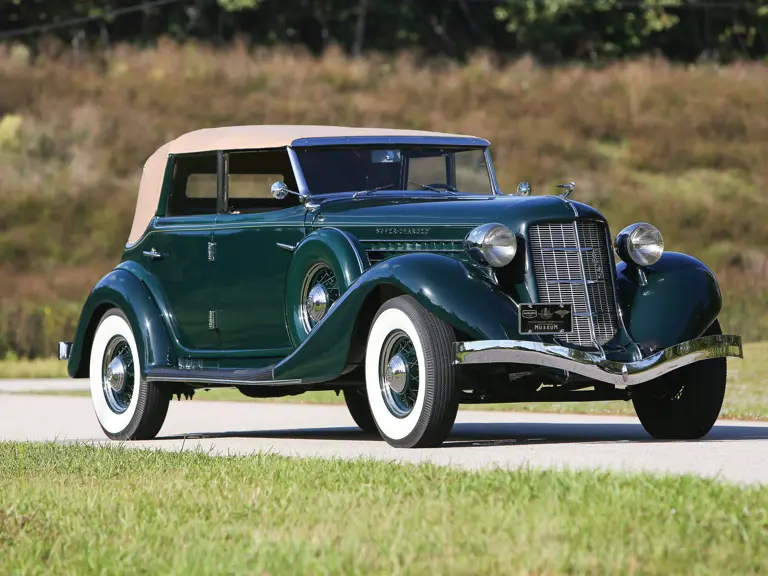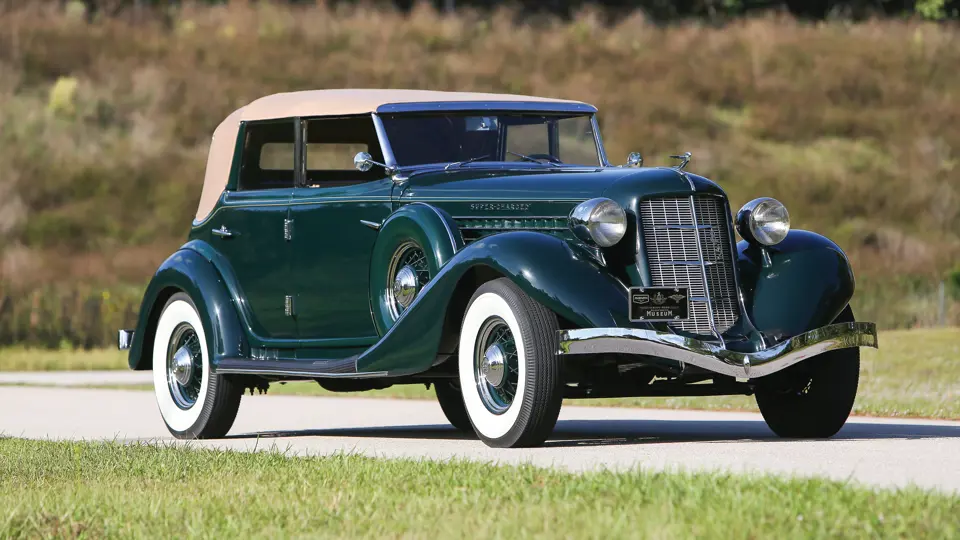The beautiful supercharged 852 Phaeton Sedan offered here has been driven and enjoyed by its owner, an enthusiastic Auburn, Indiana resident, on several regional ACD Club tours. Reliability has been excellent, and the car runs beautifully and performs well at highway speeds, with the optional “Dual Ratio” rear axle functioning properly, as confirmed by recent road testing by an Auctions America specialist. No less beautiful cosmetically, it is in “high-end driver” condition, with excellent chrome, interior, and top, and only slight age showing to the rich green paint.
The tan leather interior is an attractive complement to the body tone and features elegant instrumentation with a damascene-type dashboard. The exterior exhaust pipes and optional sidemounted spare with cover add sportiness and style. Chrome headlights and factory installed trunk were both optional equipment in 1935. The trunk adds 13.5-cubic feet of luggage space. Wire wheels, whitewall tires, dual mirrors, chrome taillights and vacuum windshield wipers are all part of this desirable platform. It will continue to be an outstanding tour car and welcome at ACD Club events. The Auburn has been certified by the Auburn-Cord-Duesenberg Club as a Category No. 1, Certified Original Car. It is also one of the most drivable and enjoyable of all Full Classics, as recognized by the CCCA.
Introduced in 1935, the all-new 851 featured beautiful Gordon Buehrig-penned styling and offered an optional Switzer-Cummins centrifugal supercharger, which boosted output by 30 percent to 150-hp. Developed by Kurt Beier at Schwitzer-Cummins and adapted to the Auburn-Lycoming inline eight-cylinder engine by Augie Duesenberg and Pearl Watson, the supercharger ran at six times engine speed and generated useful boost from 2,000-rpm upwards.
The Auburn 852 was the last hurrah for the Auburn Automobile Company. As was the case with many of the independent manufacturers, their final products were often among their best. The styling, introduced in 1935, was the last Gordon Buehrig designed Auburn line to see production.
Established in 1903, the Auburn Automobile Company matured into a well-respected builder of reliable cars, but it was not until E.L. Cord assumed the company’s presidency in 1924 that its market stature grew. In fact, as the once-buoyant auto market collapsed following Black Tuesday, Auburn’s sales continued to increase. By 1931, Auburn was the 13th largest American automaker, but the triumph was short-lived, as sales fell drastically in 1932 and 1933.



 | Fort Lauderdale, Florida
| Fort Lauderdale, Florida


